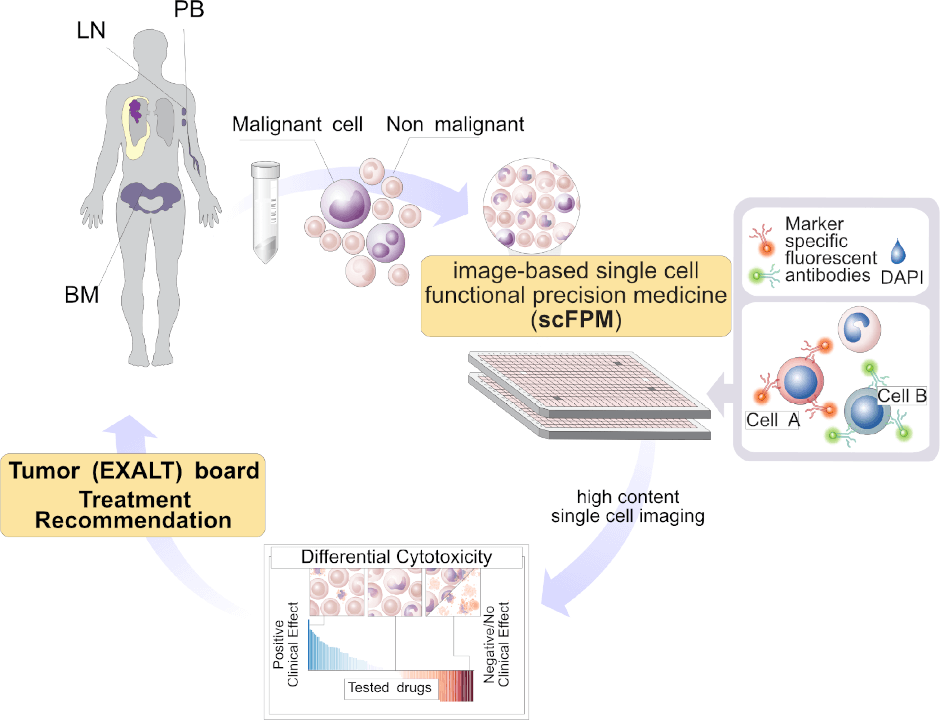Pharmacoscopy – Watching drug action under the microscope
Pharmacoscopy is a powerful technology developed in the GSF lab, enabling the quantification of single-cell events in a high-throughput and high-content manner. In collaboration with the Medical University of Vienna, we developed pharmacoscopy to screen primary patient material using automated confocal microscopy and quantify single-cell events such as differential cell death, protein expression, cell morphology– creating robust and unique data sets. Furthermore, the single-cell-to-global resolution enables the mapping of cell-cell contacts to study immune cell crosstalk.
Therapy selection guided by pharmacoscopy is effective in patients with aggressive hematological cancers

The central aim of personalized medicine is to find the right treatment for the right patient at the right time by analyzing and using specific characteristics of the patient’s tumor. Personalized therapy-matching has been primarily done based on genetic biomarkers. However, these provide treatment options for less than 10% of cancer patients. Within the framework of EXALT (Extended Analysis for Leukemia/Lymphoma Treatment), the GSF lab in collaboration with the Medical University Vienna, in particular with Philipp Staber and his team, and alumnus Berend Snijder at ETH Zurich, tested a novel approach of functional precision medicine (FPM), specifically termed “single-cell functional precision medicine (scFPM)”. In that study (Kornauth, Pemovska, Vladimer et al. Cancer Discovery, 2022), we investigated the response to drugs of healthy and malignant cells isolated from patients. scFPM facilitated the identification of drugs that show cancer cell specific efficacy, while plausibly exhibiting a reduction in side effects. High precision of this platform is achieved with automated high-content microscopy and automated image analysis, developed by the GSF lab and formerly called pharmacoscopy (as described above). We examined patients' tumor cells of real-time biopsies and directly tested the effects of more than 130 candidate compounds to determine which therapy would be effective in each patient. 54% of patients had a significant, at least more than 30% prolonged time of progression-free survival under the scFPM-guided therapy. 21% of all patients even showed a long-term response. That study demonstrates that individual therapy tailoring is feasible, and effective in breaking resistance to prior therapies. This is the first systematic prospective evaluation of a precision medicine cancer approach using a direct functional assay to instruct personalized therapies. Thus, active substances were directly tested on the patient's cell material in order to derive an individually tailored anti-cancer therapy. The most advanced patients with aggressive hematological cancers clearly benefited from the approach and the findings validate the utility, efficacy, and feasibility of integrating functional drug testing in clinical routine. We hope that this approach will continue to enable therapeutic decisions by physicians and keep the fingers crossed for future trials.
Differential drug specificities and personalized medicine
Previously, this technology has enabled us and our partner haemato-oncologists, to determine the best treatment for patients with late stage and refractory hematological malignancies. Pharmacoscopy allowed the investigation of options for personalized medicine to link into the clinical translation, hence determining the differential cytotoxicity, meaning the death of cancer cells versus healthy cells, and how this relates to patient outcome on a particular drug (Snijder et al, Lancet Haematology, 2017).
Enabling the discovery of immunomodulatory therapies
The use of immunomodulatory drugs has rapidly changed the way we think about harnessing the immune system to control cancer in patients: the goal is to modulate the physical proximity of cancer cells to cell death inducing effector cells such as NK- and T-cells. However, there had been a lack of robust methods to screen for drugs or biologics that specifically induce these necessary cell-cell contacts. Pharmacoscopy can, in very high-throughput, quantify the physical distance of cell-types of interest, enabling such investigations. We used this platform to investigate potential immunomodulatory effects in a large library of common drugs and uncovered a new mechanism of one such drug. This study can be found in our publication (Vladimer et al, Nature Chemical Biology, 2017), and was outlined very well by Derek Lowe in a post on Science Translational Medicine titled “Silently Affecting the Immune System?".